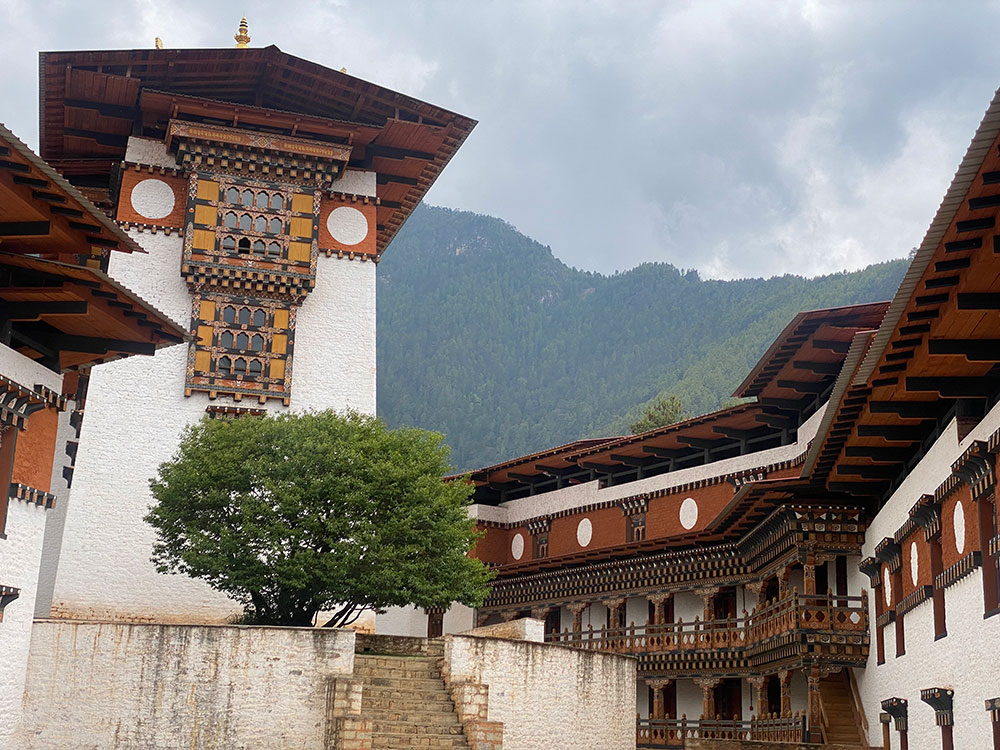Paro, Bhutan — It is a sight reminiscent of witnessing the resurrection of a cherished relic. Majestically perched atop a hill, overlooking Tsento village in Paro, the historic Drukgyel Dzong proudly stands, reclaiming its former grandeur. The revered “Fortress of Victory”, which endured a tragic calamity over seven decades ago, has now been lovingly restored.
The ambitious renovation of Drukgyel Dzong began in 2016. This iconic monument, which had been raised to the ground, was given new life under the command of His Majesty the King. The reconstruction of the dzong was intended to celebrate the birth of His Royal Highness the Gyalsey, commemorate the arrival of Zhabdrung Ngawang Namgyel in 1616 AD, and honour the birth year of Guru Rinpoche.
The project was allocated a budget of approximately Nu 500 million. Over the years, the reconstruction of Drukgyel Dzong progressed in seven distinct phases. Today, with 99 percent of the work completed, the dzong structures are once again ready to serve their purpose. Historically, the dzong, constructed in 1649, played a crucial role in regional defense.
Under the command of Zhabdrung Ngawang Namgyel, the second Druk Desi Tenzin Drukdra built the dzong as a symbol of victory over external invasions. The meticulous restoration of the dzong, coupled with exemplary project management, is truly remarkable. Despite the challenges posed by the Covid-19 pandemic, the project was successfully executed, adhering to the approved budget, and completed in December of last year.
In addition to the glorious dzong, visitors will now also have the opportunity to witness three looming watchtowers and two water towers surrounding the complex. The decision to restore and repair the watchtowers was not initially part of the plan. However, with surplus funds available, it was deemed necessary to preserve the antique aspect of the site, according to Namgay Dorji, the project director.
Namgay Dorji explained that although the watchtowers were in a state of ruin, the original structures remained intact, except for their roofs. Therefore, the restoration primarily focused on reconstructing the roofs and repairing the footpaths connecting the dzong to the towers.
To ensure authenticity, the Department of Geology and Mines conducted exhaustive surveys to assess the strength of the site and existing structures. The project also referred to photographs John Claude White took during his visit to Bhutan in 1905, as well as studying the remnants of the original building process. Designs for three sides of the dzong were derived from John Claude’s pictures, even though the dzong was in ruins, and the footpaths were already established.
The project team attributed the early completion of the works to their resourcefulness in utilising the existing machines and vehicles that were used for the construction of Ta Dzong. “We made use of available machines instead of spending time buying new ones,” Namgay Dorji said. Currently, the dzong is undergoing furnishing, and plans are underway to house Zhabdrung Lhakhang, Chenrizi Lhakhang, and Goenkhang Lhakhang in the utse of the dzong. The specific functions of each shrine are yet to be decided.

Of the allocated budget, approximately Nu 430M has been utilised for the project, demonstrating prudent financial management.
Expressing their heartfelt gratitude to His Majesty the King, Tsento Gup Chencho Gyeltshen conveyed profound thanks for the revival of their fortunes through the restoration of Drukgyel Dzong. Having grown up amidst the ruins, the gup recalled how their ancestors regarded the dzong as a source of blessings, particularly for paddy cultivation. Therefore, the dzong’s restoration carries deep significance for the community, symbolising the restoration of their fortunes and good luck.
“The elders agree that the dzong looks exactly as they had witnessed it before it was lost to the fire. We can only thank His Majesty’s compassionate heart for gifting us back this magnificent fortress,” said Gup Chencho Gyeltshen.
Though located in Tsento Gewog, the fortress is believed to be visible from every direction bordering Tsento Gewog, blessing the surrounding areas.
According to Samten Yeshi, author of Sumtrhang Monastic Landscape: Ruins in Bhutan, Their Socio-Cultural Values, and Sustaining Their Significance in Modern Times, the reconstruction of Drukgyel Dzong marks a significant milestone in the preservation of Bhutan’s historical monuments. It is the first reconstruction project of a long-time ruin and the oldest ruin to be restored in the country’s history.
The arrival of Zhabdrung Nawang Namgyel in 1616 marked a transformative era in Bhutan’s socio-political and cultural history. It brought forth a new system of fortified monasteries, known as dzongs, which served both religious and political purposes. These architectural marvels, strategically built in various regions, unified the dispersed communities and laid the foundation for the unified country we now know as Bhutan. Paro Drukgyel was one such dzong, according to Samten Yeshi.
The restoration and preservation of Bhutan’s masonry heritage have always emphasised the importance of conserving ancient monuments. In the case of Drukgyel Dzong, the renovation was executed without any Western influence but rather through a cultural process deeply rooted in Bhutanese traditions.
Yangchen C Rinzin
Research Fellow
Centre for Bhutan and GNH Studies


